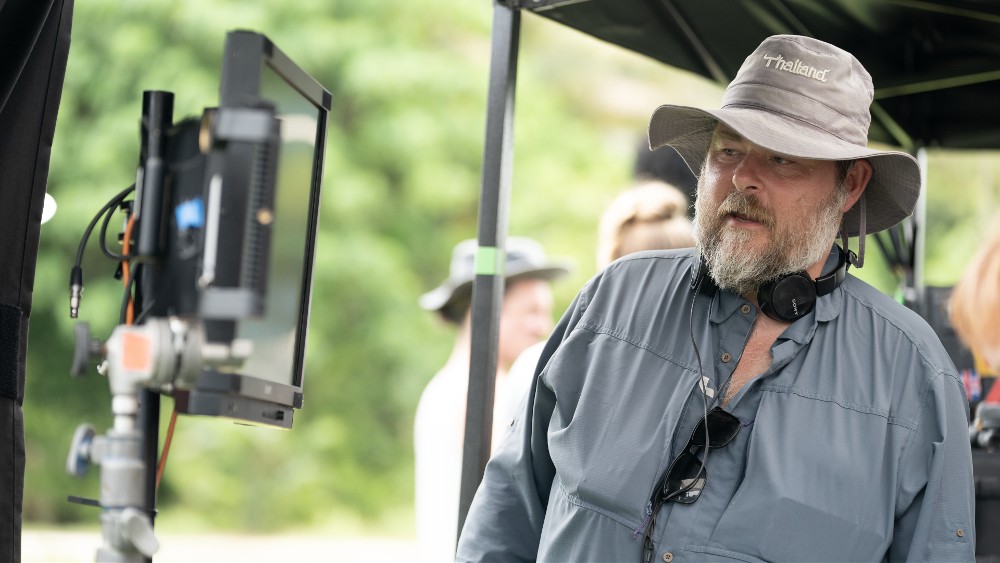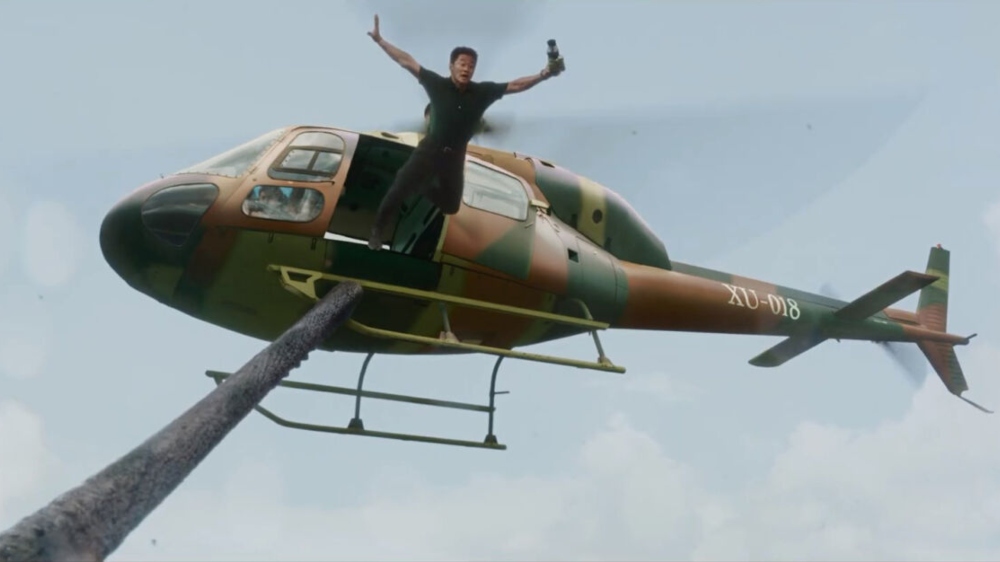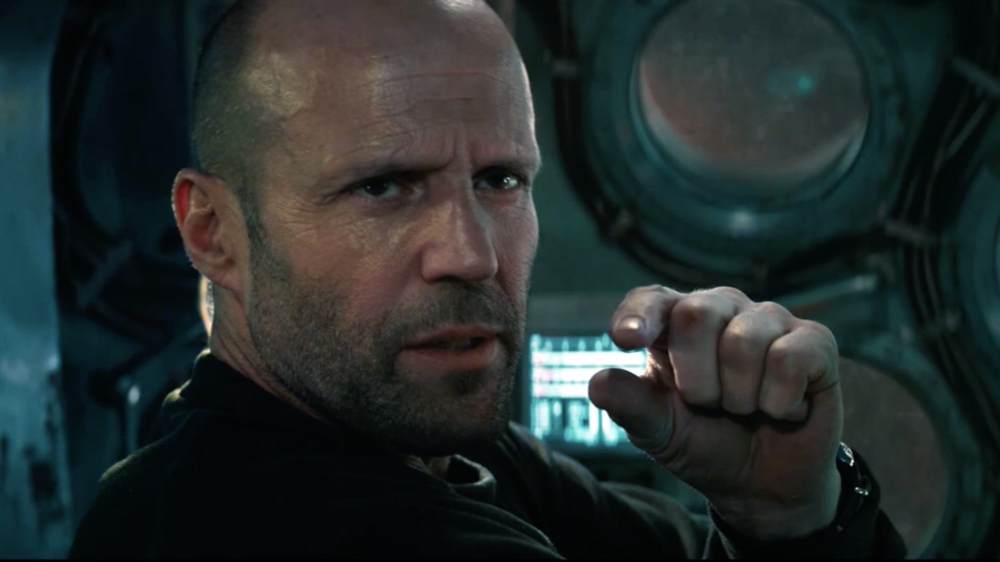When director Ben Wheatley arrived on the British indie scene in the mid-’00s with Down Terrace and Kill List, there was suddenly an exciting new voice in genre filmmaking. In the years since then, Wheatley has stretched himself, tackling challenging adaptations such as J.G. Ballard‘s High-Rise (2015) and Daphne du Maurier‘s Rebecca, which had famously been adapted by none other than Alfred Hitchcock.
When it was announced that Wheatley would be directing Meg 2: The Trench, those who have followed his career since Day 1 may have been surprised by the move, but it’ll make more sense once you’ve seen the movie and read Wheatley’s explanation for taking the big-budget studio gig.
The sequel brings back Jason Statham as eco-warrior Jonas Taylor, who is exploring the depths of the Trench in the Philippines Sea with help from other members of the Oceanic Institute, including its director, Jiuming Zhang (Chinese superstar Wu Jing), whose 14-year-old niece Meiying (Sophia Cai) has stowed away. When they get to the bottom of the Trench, they find more than they bargained for, and not just the three prehistoric Megalodon sharks, but human predators as well.
Above the Line jumped onto a Zoom call with Wheatley to talk about his biggest production to date and why he was drawn to the shark sequel, as well as what he’s working on next.

Above the Line: You were attached to direct a Tomb Raider sequel before this, so it feels like you’ve been looking for a big studio movie to direct for a while. What was it about directing a sequel to The Meg that appealed to you? Were you a fan of the books or the first movie?
Ben Wheatley: I’m more a fan of the first film. I’d seen The Meg and really enjoyed it, and then I got the script for Meg 2, and it [had] so many elements of what I was interested in. It’s weirdly what I’ve been looking for — something a bit more positive. The earlier part of my film career, it’s quite dark, and I’ve been trying to work away from that for a long time. The world of The Meg has this kind of strong positivity about it, and fun, so I wanted to stretch my legs into that. Also, I wanted to work with Statham. As an English actor, he’s fascinating — the way his career has gone and built from all these action movies moving forward, moving forward, and I really wanted to do a film with him.
ATL: Were you familiar with Steve Alton’s books? Had you read any of them?
Wheatley: No, I really didn’t [even] know about them before I started the project.
ATL: Did you want to read them to see what they based the movies on and maybe bring in some elements they didn’t include in the screenplay?
Wheatley: I looked at The Trench, and at the original Meg book, and they’re quite different, but I think they’re within the spirit of the books. Things are changed because they’re movies and they need to fit within that two-hour timeframe, [while] a book has a much larger scope than that, and it’s difficult to do that. The hope is that the [Hoeber] brothers‘ scripts kept within the spirit of Steve’s books.

ATL: You’ve directed action before — in some movies, like Free Fire, more than others — but for this, a lot of the action is underwater. What were some of the concerns you wanted to address from the get-go?
Wheatley: I was really excited about it. Basically, at this budget level, you’ve got no excuses anymore. In other movies, you might have gone, “Oh, well, we can’t do that because of X,” or “Keep the scope of it down, it has to be smaller.” With this it was like, anything you could imagine, you could do, and that was really exciting — to play with the full deck and basically… build on top of the original movie’s success.
[There was] action [and] intention, but also a lightness of tone, [and it’s] also serious and [there’s] horror, [so it] bounces back [and forth] between all those kinds of elements. I’m a big action fan, and I reveled in the chance to get to grips with this. There was a lot of thinking about action beats and structuring storyboards and thinking about how to bring as much action out of the budget as possible.
ATL: Was there any trouble getting the rating down to a PG-13 when you have sharks eating people, or did you go into it knowing that parameter so that you wouldn’t have any issues with the ratings board?
Wheatley: No, not really. The thing about it is, you’ve got a lot of creatures, and the certification stuff doesn’t really apply to human-on-creature. It only applies to human-on-human. It can be pretty hectic and intense without having to get into the parameters of certification problems. Also, because the sharks are so big, when they eat people, they just swallow them [whole].
ATL: I remember when Eli Roth was going to direct the first Meg movie and talking to him about how it would work as far as making it PG-13, and if that would be worth it. Since then, I realized that Jaws was PG, but it was a different time back then…
Wheatley: There’s a weird kind of dislocation, isn’t there, with those certifications? It seems a lot harder [than] the certifications in the past. I wonder what Jaws would have passed at now, if it was a modern film. There’s a weird thing where it seems alright because it was in the past [and] they didn’t mind giving it a lighter certification, but Jaws is pretty intense and bloody.

ATL: For sure. So, I know that Meg 2 was financed in part by Chinese money and that Wu Jing is one of the biggest stars in China — he might even be bigger than Jason Statham over there. Tell me about casting him in this movie, which I believe is his first Western film.
Wheatley: It’s interesting because it’s a Chinese co-production as well. We have Chinese partners, CMC, who put half the money up for it. The world of that is, there’s a lot of negotiation, but from both sides, from Warners and CMC, there was an appetite to make something that would play in both places. It’s not like a fish out of water, pardon the pun, East-meets-West [story]. It’s more just [about] everybody coming together. It’s about teams of people given challenges and getting through it.
We talked a lot to Wu Jing and his team, and they looked at how his character had been written, and [how] they would then adapt it for the Chinese audience and localized it, so that when it plays in China, it feels very Chinese to them. But when it plays in the West, it feels very Western. I think it’s a good balance.
ATL: Tell me about some of the new characters you had to cast for this sequel. I know it co-stars Sienna Guillory, who appeared in your movie High-Rise…
Wheatley: It’s a whole new team of submariners and research people for Mana One [Dive Centre] that we cast in. And, like you say, Sienna Guillory came in as a person involved in the research institute, without spoiling anything too much. It really does focus more on the Meiying character played by Sophia [Cai] and Wu Jing and Jason, so it makes [a] triangle of those characters and [follows] how they’re dealing with the situation.
ATL: Since you have more of a budget for this movie when you were putting together your heads of department, were there past collaborators you wanted to work with again, or did you turn to anyone who worked on the previous Meg movie? What was your guiding light in finding those people?
Wheatley: I think the first film was shot out in Australia, so a lot of HODs were all Australia-based. We retained Harry Gregson-Williams for the soundtrack, and he was amazing. It’s a real honor working with him because of his work [on] a lot of Tony Scott movies, and Ridley‘s, [too]. It was like, [Ben does a “we’re not worthy” kind of bow]… and then, Haris Zambarloukos was the DOP, [and he] did Thor and a lot of Ken Branagh movies. We shot it in Leavesden, the Warner studios in the UK, where Harry Potter was done originally. Barbie was [also] shot there. It’s like we got the A-team of British crew. It was very exciting, but I always felt kind of humbled working with them all. I basically got the art department from James Bond and Star Wars. It was like that.
ATL: Did you use the huge water tank they built at Leavesden for one of the Harry Potter movies, or did you have to go somewhere else for that?
Wheatley: We used the Potter tank. There’s an outdoor one, which we used for Mana One, and then there’s an indoor one, which is very specifically built for taking care of children doing underwater stuff in Potter. It’s got lots of filtration stuff going on, so it’s quite an advanced bit of kit.

ATL: You’ve worked with visual effects before, but never on this level, I’d imagine, where you have these creatures that are entirely CG. Did you have effects houses you wanted to use, or did you let your VFX Supe suggest those?
Wheatley: It’s a massive job. I think if I’d thought about it more, I would have been more scared of it. It was more like, you’re in a bath where they’re slowly turning up the heat, and you don’t know how hot it’s getting. I didn’t quite understand the scale of it. In the end, it was 1,700 effect shots. You’d start them, and you wouldn’t see them for six months. Some things took a year to do. So it’s a very long game, making a movie this big. My longest shoot had been Rebecca, which had been 11 weeks, but this film took two and a half years to make. You actually grow and change as a person by the time you’ve finished it, ’cause it’s gone on so long.
So that was an interesting experience. Usually, you just shoot out, and a lot of the films I’ve done had been a month or six weeks, and then you’re [the same during] the edit, and then you’re finished. You don’t really get a chance to feel like time [is] passing, but with this… They say it’s a marathon, not a sprint, but it’s basically a marathon of sprints.
ATL: As a director, you’re always going to be the busiest person on a production since you’re dealing with so many things, but there has to be downtime in the edit or during post. During those times, do you sit down and write stuff, or are you just always busy with stuff to write?
Wheatley: I don’t know. I mean, this was just so full-on. I remember when we were shooting, it was like… Cliff Lanning, who’s the Assistant Director, who’s done loads of stuff — Fast and Furious movies and Harry Potter and all that — he’s an absolute genius. I was basically fighting with him to see who could get in earliest. He would always get in before me, but the day would start at 5 a.m., and it didn’t finish for me until 9 p.m. It’s kind of the hardest thing I’ve ever done, but it was such a pleasure the whole time. It didn’t bother [me] too much.
ATL: You mentioned Harry Gregson Williams, so I have to ask about working with him. I feel like you’re fairly knowledgeable about music from previous times that we’ve spoken. You know as much about music as any filmmaker, so is he waiting until you have some kind of edit to get started on the score or does he try to get an early jump on things?
Wheatley: He’s incredibly flexible. He was on it very early, I think, because of COVID maybe, [so] that we could get him from the very start of filming. He was writing stuff all the way through. In a way, when we did the previews [previs], we didn’t preview with temp, we previewed with his music. He said that was a very unusual thing — it doesn’t usually happen.
So he’d write this brilliant music, and we’d put it on, then he’d listen to it, and he might change it again. Or we’d give feedback and he’d change it, but because of his broad experience of making so much stuff, he knew that he would give us a certain amount of slack. But he knew we respected the music he was making as well, so it kind of cut both ways, which was a great experience.
ATL: I know we’ve joked in the past about your “career plan,” but how has it changed now that you’ve finished this big movie? Do you go back to something smaller or would that be harder now, having worked with a budget like this one?
Wheatley: I’m doing a TV show at the moment, like a six-hour TV show that I’ve written myself. So that’s very different again, and it’s quite low-budget, so it’s all practical effects. No CG, no nothing. So the next thing I’m doing is a complete handbrake turn from The Meg, but then, yeah, I’d love to make another big movie like that because it was such a brilliant experience.
When you’re doing it, you can’t quite believe you’re there. It’s a real treat to have done something like that, and [I] don’t take it for granted at all. Hopefully, I get to make another one, but I don’t know. I’m going to enjoy myself for the rest of the year shooting loads of horror stuff, [doing] handheld and improvisation.
ATL: Is that being done for a company that might release it over here?
Wheatley: I hope so. We were lucky, in a way, because we were pitching it, and we didn’t get a streamer on board. I think if we had a streamer on board, we would have been shut down by now because of the Writers [Guild] and SAG strikes, so we’re actually working. We can actually film at the moment, which is good.
Warner Bros. will release Meg 2: The Trench nationwide on Friday, Aug. 4, with previews starting on Thursday night.



